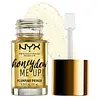What's inside
What's inside
 Key Ingredients
Key Ingredients

No key ingredients
 Benefits
Benefits

 Concerns
Concerns

 Ingredients Side-by-side
Ingredients Side-by-side

Water
Skin ConditioningGlycerin
HumectantAlcohol Denat.
AntimicrobialBetaine
HumectantHoney Extract
HumectantCollagen Extract
Skin ConditioningPortulaca Oleracea Extract
Skin ConditioningHyaluronic Acid
HumectantBifida Ferment Lysate
Skin ConditioningNelumbo Nucifera Flower Extract
Skin ConditioningJasminum Officinale Flower Extract
MaskingLavandula Angustifolia Flower Extract
CleansingRosa Centifolia Flower Extract
AstringentLilium Tigrinum Flower/Leaf/Stem Extract
Skin ConditioningIris Ensata Extract
Skin ConditioningHibiscus Sabdariffa Flower Extract
Skin ConditioningAnthemis Nobilis Flower Extract
MaskingAllantoin
Skin ConditioningCaprylyl Glycol
EmollientPEG-40 Hydrogenated Castor Oil
EmulsifyingCarbomer
Emulsion StabilisingSodium Polyacrylate
Absorbent1,2-Hexanediol
Skin ConditioningPhenoxyethanol
PreservativePotassium Hydroxide
BufferingPanthenol
Skin ConditioningBenzophenone-5
UV AbsorberDisodium EDTA
Citronellol
PerfumingLimonene
PerfumingGeraniol
PerfumingParfum
MaskingCI 77480
Cosmetic ColorantCI 15985
Cosmetic ColorantCI 19140
Cosmetic ColorantWater, Glycerin, Alcohol Denat., Betaine, Honey Extract, Collagen Extract, Portulaca Oleracea Extract, Hyaluronic Acid, Bifida Ferment Lysate, Nelumbo Nucifera Flower Extract, Jasminum Officinale Flower Extract, Lavandula Angustifolia Flower Extract, Rosa Centifolia Flower Extract, Lilium Tigrinum Flower/Leaf/Stem Extract, Iris Ensata Extract, Hibiscus Sabdariffa Flower Extract, Anthemis Nobilis Flower Extract, Allantoin, Caprylyl Glycol, PEG-40 Hydrogenated Castor Oil, Carbomer, Sodium Polyacrylate, 1,2-Hexanediol, Phenoxyethanol, Potassium Hydroxide, Panthenol, Benzophenone-5, Disodium EDTA, Citronellol, Limonene, Geraniol, Parfum, CI 77480, CI 15985, CI 19140
 Reviews
Reviews

Alternatives
Ingredients Explained
These ingredients are found in both products.
Ingredients higher up in an ingredient list are typically present in a larger amount.
Carbomer is a polymer of acrylic acid. Its main role is to create a gel consistency.
A high amount of carbomer can cause pilling or balling up of products. Don't worry, most products contain 1% or less of carbomer.
Glycerin is already naturally found in your skin. It helps moisturize and protect your skin.
A study from 2016 found glycerin to be more effective as a humectant than AHAs and hyaluronic acid.
As a humectant, it helps the skin stay hydrated by pulling moisture to your skin. The low molecular weight of glycerin allows it to pull moisture into the deeper layers of your skin.
Hydrated skin improves your skin barrier; Your skin barrier helps protect against irritants and bacteria.
Glycerin has also been found to have antimicrobial and antiviral properties. Due to these properties, glycerin is often used in wound and burn treatments.
In cosmetics, glycerin is usually derived from plants such as soybean or palm. However, it can also be sourced from animals, such as tallow or animal fat.
This ingredient is organic, colorless, odorless, and non-toxic.
Glycerin is the name for this ingredient in American English. British English uses Glycerol/Glycerine.
Learn more about GlycerinParfum is a catch-all term for an ingredient or more that is used to give a scent to products.
Also called "fragrance", this ingredient can be a blend of hundreds of chemicals or plant oils. This means every product with "fragrance" or "parfum" in the ingredients list is a different mixture.
For instance, Habanolide is a proprietary trade name for a specific aroma chemical. When used as a fragrance ingredient in cosmetics, most aroma chemicals fall under the broad labeling category of “FRAGRANCE” or “PARFUM” according to EU and US regulations.
The term 'parfum' or 'fragrance' is not regulated in many countries. In many cases, it is up to the brand to define this term.
For instance, many brands choose to label themselves as "fragrance-free" because they are not using synthetic fragrances. However, their products may still contain ingredients such as essential oils that are considered a fragrance by INCI standards.
One example is Calendula flower extract. Calendula is an essential oil that still imparts a scent or 'fragrance'.
Depending on the blend, the ingredients in the mixture can cause allergies and sensitivities on the skin. Some ingredients that are known EU allergens include linalool and citronellol.
Parfum can also be used to mask or cover an unpleasant scent.
The bottom line is: not all fragrances/parfum/ingredients are created equally. If you are worried about fragrances, we recommend taking a closer look at an ingredient. And of course, we always recommend speaking with a professional.
Learn more about ParfumPeg-40 Hydrogenated Castor Oil is derived from castor oil and polyethylene glycol (PEG). It is used as a emollient and emulsifier.
As an emulsifier, it helps prevent ingredients from separating. It also helps make the other ingredients more soluble; it is often used to solubilize fragrances. This increases spreadability and elongates shelf life in a product.
Emollients help soothe and soften the skin. They do this by creating a protective film on your skin. This barrier helps trap moisture and keeps your skin hydrated. Emollients may be effective at treating dry or itchy skin.
This ingredient may or may not be vegan, depending on the source.
Peg-40 Hydrogenated Castor Oil may not be fungal-acne safe. We recommend speaking with a professional if you have any questions or concerns.
Learn more about PEG-40 Hydrogenated Castor OilPhenoxyethanol is a preservative that has germicide, antimicrobial, and aromatic properties. Studies show that phenoxyethanol can prevent microbial growth. By itself, it has a scent that is similar to that of a rose.
It's often used in formulations along with Caprylyl Glycol to preserve the shelf life of products.
Water. It's the most common cosmetic ingredient of all. You'll usually see it at the top of ingredient lists, meaning that it makes up the largest part of the product.
So why is it so popular? Water most often acts as a solvent - this means that it helps dissolve other ingredients into the formulation.
You'll also recognize water as that liquid we all need to stay alive. If you see this, drink a glass of water. Stay hydrated!
Learn more about Water